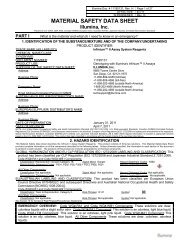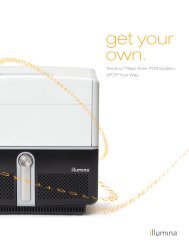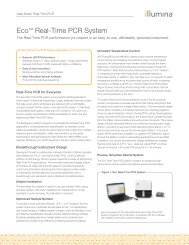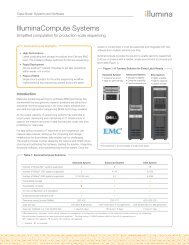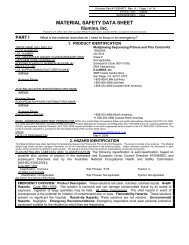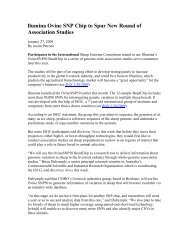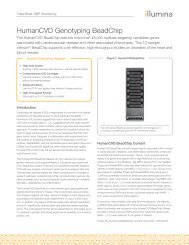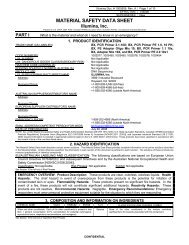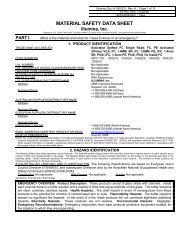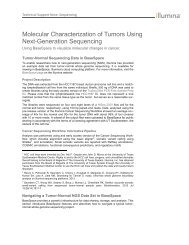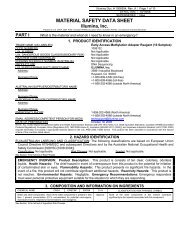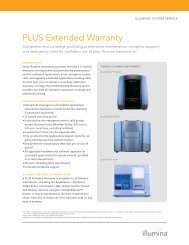MATERIAL SAFETY DATA SHEET - Illumina
MATERIAL SAFETY DATA SHEET - Illumina
MATERIAL SAFETY DATA SHEET - Illumina
You also want an ePaper? Increase the reach of your titles
YUMPU automatically turns print PDFs into web optimized ePapers that Google loves.
TruSeq Enrichment Kit <strong>Illumina</strong> Doc. #15018476, Rev. A Page 6 of 17<br />
8. EXPOSURE CONTROLS - PERSONAL PROTECTION (Continued)<br />
RESPIRATORY PROTECTION: Respiratory protection is not generally needed when using this product. Maintain<br />
airborne contaminant concentrations below limits listed above. In instances where inhalable mists or sprays of<br />
product may be generated and respiratory protection is necessary, use only respiratory protection authorized in the<br />
U.S. Federal OSHA Respiratory Protection Standard (29 CFR 1910.134), equivalent U.S. State standards,<br />
Canadian CSA Standard Z94.4-02, European Standard EN 529:2005, EU member state standards, Australian<br />
Standard 1716-Respiratory Protective Devices and Australian Standard 1715-Selection, Use, and Maintenance of<br />
Respiratory Protective Devices, or Japanese Standard JIS T 8150:2006. Oxygen levels below 19.5% are<br />
considered IDLH by OSHA. In such atmospheres, use of a full-facepiece pressure/demand SCBA or a full<br />
facepiece, SAR with auxiliary self-contained air supply is required under OSHA’s Respiratory Protection Standard<br />
(1910.134-1998). Specific NIOSH recommendations on personal protective equipment for Alkali Hydroxide in air are<br />
as follows:<br />
ALKALI HYDROXIDE<br />
CONCENTRATION RESPIRATORY PROTECTION<br />
Up to 10 mg/m 3 : Supplied Air Respirator (SAR) operated in a continuous flow mode; full facepiece respirator with highefficiency<br />
particulate filter(s); powered air-purifying respirator with dust and mist filter(s); full-facepiece<br />
Self-Contained Breathing Apparatus (SCBA); or full-facepiece SAR.<br />
Emergency or Planned Entry into Unknown Concentrations or IDLH Conditions: Positive pressure, full-facepiece SCBA or<br />
positive pressure, full-facepiece SAR with an auxiliary positive pressure SCBA.<br />
Escape:<br />
Full-facepiece respirator with high-efficiency particulate filter(s); or escape-type SCBA.<br />
EYE PROTECTION: Depending on the use of this product, splash goggles or safety glasses may be worn. Use<br />
goggles or safety glasses for spill response, as stated in Section 6 (Accidental Release Measures) of this MSDS. If<br />
necessary, refer to U.S. OSHA 29 CFR 1910.133, Canadian CSA Standard Z94.3-07, European Standard CR<br />
13464:1999, Australian Standard 1337-Eye Protection for Industrial Applications and Australian Standard 1336-<br />
Recommended Practices for Eye Protection in the Industrial Environment, or Japanese Standard JIS T<br />
8147:2003.<br />
HAND PROTECTION: Wear butyl rubber, neoprene, or nitrile rubber or latex gloves for routine use. If necessary,<br />
refer to U.S. OSHA 29 CFR 1910.138, appropriate standards of Canada, the Australian Standard 2161-Industrial<br />
Safety Gloves and Mittens, European Standard CEN/TR 15419:2006, or Japanese Standard JIS T 8116:2005.<br />
BODY PROTECTION: Use body protection appropriate for task, such as a lab coat. If necessary, use body<br />
protection appropriate for task (e.g., Tyvek suit, rubber apron). If necessary, refer to OSHA Technical Manual<br />
(Section VII: Personal Protective Equipment), appropriate Canadian Standards, the European Standard CEN/TR<br />
15419:2006, Australian Standard 3765-Clothing for Protection Against Hazardous Chemicals, or Japanese<br />
Standard JIS T 8030:2005. If a hazard of injury to the feet exists due to falling objects, rolling objects, where<br />
objects may pierce the soles of the feet or where employee’s feet may be exposed to electrical hazards, use foot<br />
protection, as described in U.S. OSHA 29 CFR 1910.136 and the Canadian CSA Standard Z195-02, Protective<br />
Footwear.<br />
9. PHYSICAL and CHEMICAL PROPERTIES<br />
APPEARANCE, ODOR and COLOR:<br />
TC#-CT1, TC#-SMB, and TC#-WS1: These components are clear, colorless liquids with a mildly sulfurous odor.<br />
All Other Solutions: These solutions are clear, colorless, odorless liquids.<br />
HOW TO DETECT THESE SUBSTANCES:<br />
GA#-HP3: Litmus paper will turn blue when in contact with this solution.<br />
TC#-CT1, TC#-SMB, and TC#-WS1: The odor may act as a warning property associated with these liquids.<br />
All Other Solutions: There are no unusual warning properties associated with these components.<br />
pH:<br />
GA#-HP3: 14 All Other Solutions: 6–10<br />
FLASH POINT: Not applicable.<br />
FLAMMABILITY: Not flammable.<br />
EXPLOSIVE PROPERTIES: Not explosive<br />
OXIDIZING PROPERTIES: Not oxidizers.<br />
VAPOR PRESSURE: Not established.<br />
SPECIFIC GRAVITY: Not established.<br />
SOLUBILITY: Miscible in some organic solvents. SOLUBILITY IN WATER: Completely soluble.<br />
BOILING POINT: Not established.<br />
MELTING/FREEZING POINT: Not established.<br />
VISCOSITY: Not established.<br />
RELATIVE VAPOR DENSITY (air = 1): Not established.<br />
EVAPORATION RATE (n-BuAc = 1): Similar to water. ODOR THRESHOLD: Not established.<br />
COEFFICIENT OF OIL/WATER DISTRIBUTION (PARTITION COEFFICIENT): Not established.<br />
10. STABILITY AND REACTIVITY<br />
DECOMPOSITION CONDITIONS/STABILITY: Stable.<br />
DECOMPOSITION PRODUCTS:<br />
Combustion: Carbon oxides, dimethyl amine, hydrogen sulfide, phosphine, cyanides, hydrogen chloride, and phosphorous,<br />
sodium and nitrogen oxides.<br />
Hydrolysis: None known.



